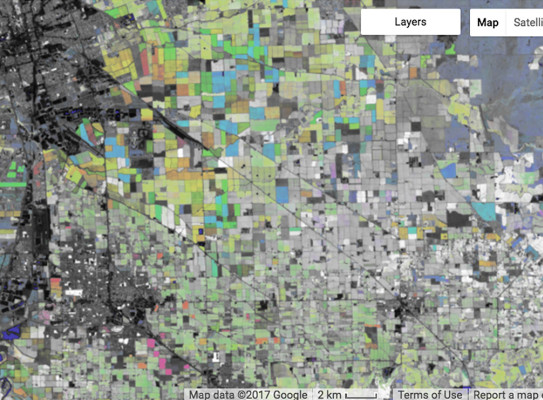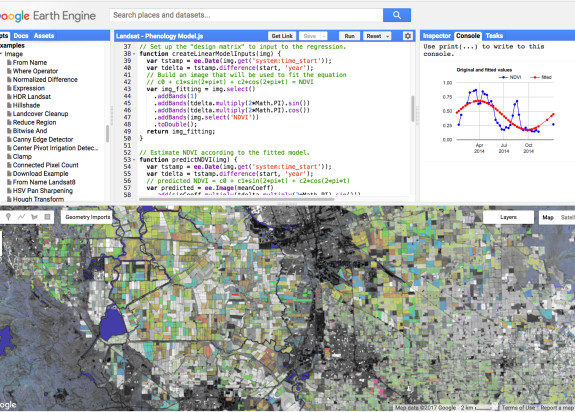
Envirolink toolsDeveloping a collaborative satellite data workspace for regional councils

This project developed a suite of standard processing methods for satellite data of land-use change, wetland dynamics, flood and drought impacts, coastal change and forestry change.
Overview
Google Earth Engine (GEE) is a game-changer for New Zealand regional council and other environmental scientists when it comes to using satellite data to identify and map land, soil, vegetation and inland water consistently across all regions. This cloud-computing service for satellite data processing enables data and methods to be easily shared between all regional councils.
Regional councils no longer have to download and process data vast amounts of data. Instead, they can use tutorials and lessons learnt in a collaborative platform called ‘EnviroSatTools’ to tailor and adjust data to their own needs. Central government scientists can also access the data for their own research.
The project aimed to
- work with regional councils and satellite remote sensing experts to test the opportunities and challenges for regional councils to share each other’s scripts and data in a collaborative platform built on GEE
To achieve these objectives, we
- developed a suite of methods and algorithms in GEE that assesses a range of factors applicable at both national and regional scale
- delivered one-on-one training at regional councils and six-monthly national training workshops
- created guidelines outlining the explanation and possible uses of the methods and algorithms
The project
The project included one-on-one training and six-monthly national workshops for regional councils. The goal was to build capability with the Google Earth Engine (GEE) tools for each regional council’s specific criteria and applications.
Training was provided by domain experts across New Zealand – GNS Science, University of Auckland, Indufor, Manaaki Whenua Landcare Research and Xerra.
EnviroSatTools transcript
All these land use changes - we want regional councils to be able to better map those.
We needed a tool that could help scientists across New Zealand to work with these data in a more unified way.
I did a PhD in 2017 and I used satellite data for that.
I downloaded terabytes and terabytes of data to my own computers which literally took months. I processed them
on my own computer which also took months.
Then I found out that there are tools available that can do that in a matter of like 10 or 15 seconds.
The core of that tool is called the Google Earth engine that basically collects all satellite data from the 80s up to today
and makes them available in one archive and in one environment in the cloud where you can just from your web browser basically do your processing. You don't have to download these data - you can combine the data easily. You can make quick maps, all versioned or able to share with other people.
Runs in a few seconds.
The workspace that we've developed is called enviroset tools and that basically consists of three different subtools.
The technical core is the Google Earth Engine.
This is basically where the satellite data processing takes place – in the cloud. The second part is a q a web forum in the form of a Google group where people can chat with each other share findings ask questions etc. and the third
part is a project wiki which is basically a web page. It's easily editable by anyone that has the documentation of all the applications that we've been developing.
[Music]
Hello dr alan. Hello doctor. we're here.
One sentence that captures it all for our project.
this is a hard one eh i think the real difference and the real advantage of using cloud-based computing is that you're not having to search for imagery and download it and process it. It all happens on the cloud and it has an alert system so it'll alert you if there's a change in vegetation so you don't need to be sitting at your desk and going through aerial photographs or going through satellite imagery every day.
hey so it's all right if i call you oogie right because everyone called you augie
is good you've done so much by the way with these tools before the project started
yeah i had a bit of an early exposure there it turned out to be a really good way of quickly prototyping ideas and getting access to data that's otherwise hiding in catalogs. what i see you guys have achieved is that you've
you've kicked out of the community and it is up to us now to keep it going and to bring more people in okay the long and short of it after two years of development in the envirosid tools project we have a set of applications which we
made with regional councils we've developed workshops with regional councils where we have educated those tools and the end result is the collaborative workspace. That collaborative workspace is now yours and we've designed it in such a way that you can develop further extend further build in more advanced technology and I encourage you to go to this particular website to find more information.
Please check it out – it is your turn now to make it happen.
Good luck.
EnviroSatTools
Working collaboratively
The collaborative workspace has three main components:
- GEE; a game-changer that significantly speeds up and standardises the processing, analysis and visualisation of satellite data. An archive of multi-petabytes of satellite data can be processed in the cloud, without the need to download or process on inhouse computers
- a web-forum to share findings and ask technical questions
- a home for methods, algorithms and documentation, based on the Git Software, including a Wiki space for documentation
Pilot studies
The project developed five application modules:
- change detection
- wetlands
- forestry change
- flood mapping
These modules were prioritised by regional councils. Each module contains one or more applications, coded in GEE. Each application can be used directly or adapted, e.g. different region of interest.
Google Earth Engine
Google Earth Engine (GEE) is a processing platform that facilitates easier and more shareable satellite remote sensing data analyses. GEE takes away the high computational burden of having to download and process vast amounts of satellite data. It also hosts and processes datasets, reducing data compilation efforts and increasing analytical efficiency.
In Google’s own words:
“Google Earth Engine is a cloud-based platform for planetary-scale geospatial analysis that brings Google's massive computational capabilities to bear on a variety of high-impact societal issues including deforestation, drought, disaster, disease, food security, water management, climate monitoring and environmental protection. It is unique in the field as an integrated platform designed to empower not only traditional remote sensing scientists, but also a much wider audience that lacks the technical capacity needed to utilize traditional supercomputers or large-scale commodity cloud computing resources.”


Research programme details
Project partners: University of Auckland, Indufor, Xerra, Manaaki Whenua Landcare Research
Duration
2019–2021
Funding platform
Status
Project lead
Rogier Westerhoff, GNS Science
Funder
New Zealand Ministry of Business, Innovation & Employment (MBIE)